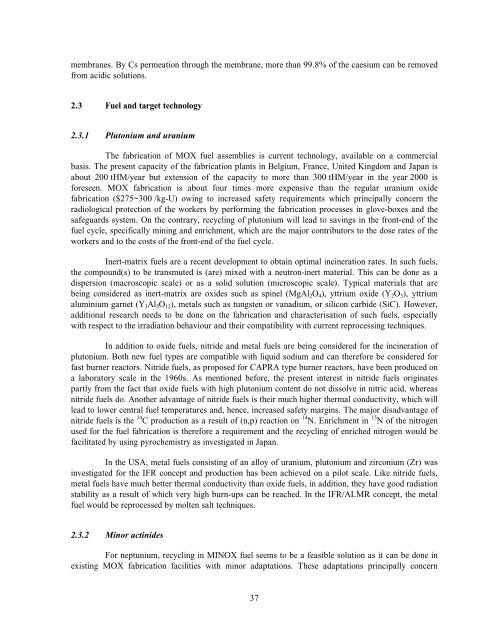COMPLETE DOCUMENT (1862 kb) - OECD Nuclear Energy Agency
COMPLETE DOCUMENT (1862 kb) - OECD Nuclear Energy Agency
COMPLETE DOCUMENT (1862 kb) - OECD Nuclear Energy Agency
Create successful ePaper yourself
Turn your PDF publications into a flip-book with our unique Google optimized e-Paper software.
membranes. By Cs permeation through the membrane, more than 99.8% of the caesium can be removed<br />
from acidic solutions.<br />
2.3 Fuel and target technology<br />
2.3.1 Plutonium and uranium<br />
The fabrication of MOX fuel assemblies is current technology, available on a commercial<br />
basis. The present capacity of the fabrication plants in Belgium, France, United Kingdom and Japan is<br />
about 200 tHM/year but extension of the capacity to more than 300 tHM/year in the year 2000 is<br />
foreseen. MOX fabrication is about four times more expensive than the regular uranium oxide<br />
fabrication ($275~300 /kg-U) owing to increased safety requirements which principally concern the<br />
radiological protection of the workers by performing the fabrication processes in glove-boxes and the<br />
safeguards system. On the contrary, recycling of plutonium will lead to savings in the front-end of the<br />
fuel cycle, specifically mining and enrichment, which are the major contributors to the dose rates of the<br />
workers and to the costs of the front-end of the fuel cycle.<br />
Inert-matrix fuels are a recent development to obtain optimal incineration rates. In such fuels,<br />
the compound(s) to be transmuted is (are) mixed with a neutron-inert material. This can be done as a<br />
dispersion (macroscopic scale) or as a solid solution (microscopic scale). Typical materials that are<br />
being considered as inert-matrix are oxides such as spinel (MgAl 2 O 4 ), yttrium oxide (Y 2 O 3 ), yttrium<br />
aluminium garnet (Y 3 Al 5 O 12 ), metals such as tungsten or vanadium, or silicon carbide (SiC). However,<br />
additional research needs to be done on the fabrication and characterisation of such fuels, especially<br />
with respect to the irradiation behaviour and their compatibility with current reprocessing techniques.<br />
In addition to oxide fuels, nitride and metal fuels are being considered for the incineration of<br />
plutonium. Both new fuel types are compatible with liquid sodium and can therefore be considered for<br />
fast burner reactors. Nitride fuels, as proposed for CAPRA type burner reactors, have been produced on<br />
a laboratory scale in the 1960s. As mentioned before, the present interest in nitride fuels originates<br />
partly from the fact that oxide fuels with high plutonium content do not dissolve in nitric acid, whereas<br />
nitride fuels do. Another advantage of nitride fuels is their much higher thermal conductivity, which will<br />
lead to lower central fuel temperatures and, hence, increased safety margins. The major disadvantage of<br />
nitride fuels is the 14 C production as a result of (n,p) reaction on 14 N. Enrichment in 15 N of the nitrogen<br />
used for the fuel fabrication is therefore a requirement and the recycling of enriched nitrogen would be<br />
facilitated by using pyrochemistry as investigated in Japan.<br />
In the USA, metal fuels consisting of an alloy of uranium, plutonium and zirconium (Zr) was<br />
investigated for the IFR concept and production has been achieved on a pilot scale. Like nitride fuels,<br />
metal fuels have much better thermal conductivity than oxide fuels, in addition, they have good radiation<br />
stability as a result of which very high burn-ups can be reached. In the IFR/ALMR concept, the metal<br />
fuel would be reprocessed by molten salt techniques.<br />
2.3.2 Minor actinides<br />
For neptunium, recycling in MINOX fuel seems to be a feasible solution as it can be done in<br />
existing MOX fabrication facilities with minor adaptations. These adaptations principally concern<br />
37
















